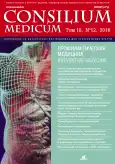The efficacy of antiarrhythmic therapy in the early postoperative period of catheter isolation of the mouths of the pulmonary veins for the treatment of paroxysmal atrial fibrillation
- Authors: Tarasov A.V1, Davtyan K.V1, Miller O.N2, Shatakhtsyan V.S1
-
Affiliations:
- State Research Center for Preventive Medicine of the Ministry of Health of the Russian Federation
- Novosibirsk State Medical University
- Issue: Vol 18, No 12 (2016)
- Pages: 49-54
- Section: Articles
- URL: https://journals.rcsi.science/2075-1753/article/view/94585
- ID: 94585
Cite item
Full Text
Abstract
Full Text
##article.viewOnOriginalSite##About the authors
A. V Tarasov
State Research Center for Preventive Medicine of the Ministry of Health of the Russian Federation
Email: a730tv@yandex.ru
канд. мед. наук, ст. науч. сотр. лаб. рентгенохирургических методов лечения аритмий сердца ФГБУ ГНИЦ ПМ 101990, Russian Federation, Moscow, Petroverigskii per., d. 10, str. 3
K. V Davtyan
State Research Center for Preventive Medicine of the Ministry of Health of the Russian Federationд-р мед. наук, зав. лаб. рентгенохирургических методов лечения аритмий сердца ФГБУ ГНИЦ ПМ 101990, Russian Federation, Moscow, Petroverigskii per., d. 10, str. 3
O. N Miller
Novosibirsk State Medical Universityд-р мед. наук, проф. каф. неотложной терапии с эндокринологией и профпатологией фак-та повышения квалификации и профессиональной переподготовки врачей ФГБОУ ВО НГМУ 630091, Russian Federation, Novosibirsk, ul. Krasnyi pr-t, d. 52
V. S Shatakhtsyan
State Research Center for Preventive Medicine of the Ministry of Health of the Russian Federationмл. науч. сотр. лаб. рентгенохирургических методов лечения аритмий сердца ФГБУ ГНИЦ ПМ 101990, Russian Federation, Moscow, Petroverigskii per., d. 10, str. 3
References
- Kirchhof P, Benussi S, Kotecha D et al. 2016 Esc Guidelines for the management of atrial fibrillation developed in collaboration with EACTS. The Task Force for the management of atrial fibrillation of the ESC. Developed with the special contribution of the EHRA of the ESC. Endorsed by the ESO. Eur Heart J. doi: 10.1093/eurheartj/ehw210.
- Диагностика и лечение фибрилляции предсердий. Рекомендации РКО и ВНОА, 2012. Рос. кардиол. журн. 2013; 4 (102; Прил. 3): 6-7, 61-76.
- Schotten U, Verheule S, Kirchhof P, Goette A. Pathophysiological mechanisms of atrial fibrillation - a translational appraisal. Physiol Rev 2010.
- Pappone E, Rosanio S, Oreto G et al. Circumferential Radiofrequency Ablation of Pulmonary Vein Ostia A New Anatomic Approach for Curing Atrial Fibrillation Carlo. Circulation 2000; 102: 2619-28.
- Calkins H, Kuck K.H, Cappato R et al. 2012 HRS/EHRA/ECAS Expert Consensus statement on catheter and surgical ablation of atrial fibrillation: recommendations for patient selection, procedural techniques, patient management and follow - up, definitions, endpoints, and research trial design. Europace 2012; 14 (4): 528-606.
- Julio J, Chierchia G-B, Chierchia C et al. Regular atrial tachycardias following vein isolation for paroxysmal atrial fibrillation: a comparison between the cryoballoon and radiofrequency techniques. J Interv Card Electrophysiol 2015; 42: 161-9.
- Stabile G, Bertaglia E, Senatore G et al. Catheter ablation treatment in patients with drug - refractory atrial fibrillation: a prospective, multi - centre, randomized, controlled study (Catheter Ablation For The Cure Of Atrial Fibrillation Study). Eur Heart J 2006; 27 (2): 216-21.
- Rordorf R, Savastano S, Gandolfi E et al. Pharmacological therapy following catheter ablation of atrial fibrillation. J Cardiovasc Med (Hagerstown) 2012; 13 (1): 9-15.
- Roux J.F, Zado E, Callans D.J et al. Antiarrhythmics After Ablation of Atrial Fibrillation (5A Study). Circulation 2009; 120 (12): 1036-40.
- Leong-Sit P, Roux J.F, Zado E et al. Antiarrhythmics after ablationof atrial fibrillation (5A Study): six - month follow - up study. Circ Arrhythm Electrophysiol 2011; 4 (1): 11-4.
- Goldenberg G.R, Burd D, Lodzinski P et al. Antiarrhythmic therapy as an adjuvant to promote post pulmonary vein isolation success - a meta - analysis. J Interv Card Electrophysio 2016; 21: 98-109.
- January C.T, Wann S, Alpert J.S et al. 2014 AHA/ACC/HRSGuidelines for the Management of Patients With Atrial Fibrillation: Executive Summary. J American College Cardiology. doi: 10.1016/j.jacc.2014.03.021.
- Миллер О.Н., Тарасов А.В., Дик И.С., Беляева И.Е. Купирование фибрилляции предсердий на догоспитальном и стационарном этапах с позиций доказательной медицины // Consilium Medicum. 2016; 18 (10): 8-18.
Supplementary files






